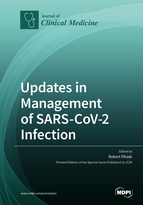Updates in Management of SARS-CoV-2 Infection
A special issue of Journal of Clinical Medicine (ISSN 2077-0383). This special issue belongs to the section "Infectious Diseases".
Deadline for manuscript submissions: closed (30 June 2023) | Viewed by 43885
Special Issue Editor
Interests: infectious diseases; viral hepatitis; liver; COVID-19
Special Issues, Collections and Topics in MDPI journals
Special Issue Information
Dear Colleagues,
Severe acute respiratory syndrome coronavirus 2 (SARS‑CoV‑2) has spread worldwide from the beginning of 2020. The infection is mostly asymptomatic but some patients may develop COVID‑19 (coronavirus disease 2019) with a severe or critical course leading to pneumonia, acute respiratory distress syndrome, and multiorgan failure. Apart from the virus‑related damage of the lungs, pathomechanism of the disease seems to be linked to thromboembolism and inflammation accompanied by overproduction of proinflammatory cytokines, termed a cytokine storm, responsible for multiorgan damage and death. Since the development of a new therapeutic molecule, dedicated strictly to a particular virus is time‑consuming, physicians and scientists have started to test and repurpose old medications. Unfortunately, after one year of pandemics, there is still a lack of optimal therapy and no clear indicators of recovery. A major issue is also insufficient knowledge on predictors of the severe or deadly course of the disease, which could also help to switch from one therapeutic option to another. Due to many gaps still existing in the management of COVID-19, there is a need for the accumulation of new data particularly from real-world experience, which could be applicable to practice guidelines. The objective of this Topical Collection of the Journal of Clinical Medicine is to provide an update on the management for the diagnostic workup and pharmacotherapy of SARS‑CoV‑2 infection.
Prof. Dr. Robert Flisiak
Collection Editor
Manuscript Submission Information
Manuscripts should be submitted online at www.mdpi.com by registering and logging in to this website. Once you are registered, click here to go to the submission form. Manuscripts can be submitted until the deadline. All submissions that pass pre-check are peer-reviewed. Accepted papers will be published continuously in the journal (as soon as accepted) and will be listed together on the special issue website. Research articles, review articles as well as short communications are invited. For planned papers, a title and short abstract (about 100 words) can be sent to the Editorial Office for announcement on this website.
Submitted manuscripts should not have been published previously, nor be under consideration for publication elsewhere (except conference proceedings papers). All manuscripts are thoroughly refereed through a single-blind peer-review process. A guide for authors and other relevant information for submission of manuscripts is available on the Instructions for Authors page. Journal of Clinical Medicine is an international peer-reviewed open access semimonthly journal published by MDPI.
Please visit the Instructions for Authors page before submitting a manuscript. The Article Processing Charge (APC) for publication in this open access journal is 2600 CHF (Swiss Francs). Submitted papers should be well formatted and use good English. Authors may use MDPI's English editing service prior to publication or during author revisions.
Keywords
- severe acute respiratory syndrome coronavirus 2 (SARS‑CoV‑2)
- COVID‑19 (coronavirus disease 2019)
- management of COVID-19
- management for the diagnostic workup
- pharmacotherapy of SARS‑CoV‑2 infection







